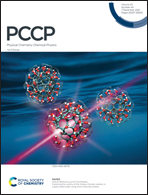Thermally activated delayed fluorescence materials with aggregation-induced emission properties: a QM/MM study†
Abstract
Organic molecules with thermally activated delayed fluorescence (TADF) and aggregation induced emission (AIE) properties have attracted increasing research interest due to their great potential applications in organic light emitting diodes (OLEDs), especially for those with multicolor mechanochromic luminescence (MCL) features. Theoretical research on the luminescence characteristics of organic TADF emitters based on the aggregation states is highly desired to quantify the relationship between the TADF properties and aggregation states. In this work, we study the 4,4′-(6-(9,9-dimethylacridine-10(9H)-yl)quinoline-2,3-dibenzonitrile (DMAC-CNQ) emitter with TADF and AIE properties, and calculate the photophysical properties in gas, solid and amorphous states by using the quantum mechanics and molecular mechanics (QM/MM) method. Our simulations demonstrate that the aggregation states enhance obviously the reverse intersystem crossing rates and transition dipole moments of the DMAC-CNQ emitter, and suppress the non-radiative rates from the lowest excited singlet state (S1) to ground state (S0). Specifically, the molecular stacking of DMAC-CNQ in solid phases can mainly restrict the geometric torsion of the DMAC moiety for decreasing non-radiative decay rates, and the torsion of the CNQ moiety for increasing the reverse intersystem crossing rates. As a result, the calculated fluorescence efficiencies of the DMAC-CNQ emitter in the crystal and amorphous states are 67% and 26% respectively, and in good agreement with the experimental results.



 Please wait while we load your content...
Please wait while we load your content...